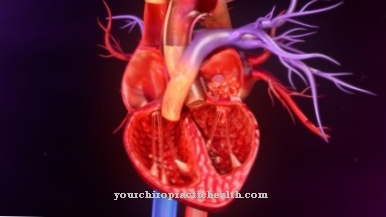At the Membrane transport substances pass through a biological membrane or are actively transported through membranes. In contrast to active transport, diffusion is the simplest membrane transport route and does not require any additional energy. Membrane transport disorders are associated with a variety of different diseases.
What is membrane transport?

Biomembranes enclose areas such as the cytoplasm of cells and thus generate a controlled region with a relatively independent milieu from the outside world. The specific cell environment inside cells can only be built up and maintained due to the shielding from the outside world.
The double layer of a biomembrane consists of phospholipids and is inherently only permeable to gases and small, in most cases uncharged molecules. For hydrophilic polar ions and other bioactive substances, the lipid bilayer corresponds to a barrier, which additional transport mechanisms are required to overcome.
Membrane transport corresponds to the passage of substances through a biomembrane. Two different principles play a role here. The first principle is diffusion or free permeation, the second is selective mass transport. In addition to simple diffusion, functional principles such as passive transport through channel proteins or carrier proteins and active transport for transmembrane transport also count.
Endocytosis, exocytosis and transcytosis belong to the membrane-displacing transport. Since membrane parts themselves are shifted during membrane-displacing transport, a membrane flow is sometimes also mentioned here.
Membrane transport supports cell functions and cell communication with the environment. Selective mass transfer is made possible by the transport mechanisms.
Function & task
The lipid bilayer or bimolecular lipid layer of a biomembrane corresponds to a barrier between aqueous compartments in the form of the extraplasmic and cytoplasmic space. Only small molecules can diffuse through a biomembrane between the compartments, for example acetic acid as well as water. For larger molecules the diffusion rate is relatively low.
The permeability of membranes for small molecules is also known as semipermeability and forms the basis of osmosis. According to current assumptions, every biomembrane is a fluid structure with temporary irregularities within the lipid bilayer. Molecules with a hydrophobic property dissolve through the hydrophobic membrane area due to their distribution coefficient. Even larger particles like steroid hormones can diffuse across membranes.
In contrast, specific molecules make use of specific membrane transport. The transport route is tied to integral membrane transport proteins known as translocators. The specific transport is substrate-specific and saturable. The translocators of this transport route include carriers that are loaded with the substrate and that can bring about a conformational change in the membrane in order to introduce its charge.
Due to the relatively high transport rates, there is a permanent transport channel in each membrane. The integral membrane proteins with functions in membrane transport usually correspond to oligomeric structures. In the case of specific transport, there is catalyzed diffusion without additional energy consumption or active transport with energy consumption.
Catalyzed diffusion and active transport offer the possibility of transporting only a single particle unidirectionally, and two particles together in the same direction or in opposite directions. Catalyzed diffusion through membrane transport proteins only follows the concentration equalization along the existing concentration gradient of substances between the two compartments of the cell. Active transport always takes place against the concentration gradient.
Pores of the outer biomembrane are used for the unspecific passage of hydrophilic particles. The actual transport channel of a biomembrane consists of β-sheets. Membrane transport is irreplaceable for all bodily functions and tissues in the body, for example for the nervous system and its voltage-dependent ion channels.
Illnesses & ailments
Disturbances in the membrane transport systems can cause severe cell damage and even organ failure. Within the intestine or the kidneys, disorders of the membrane transport result, for example, from absorption and secretion disorders.
Mitochondriopathies, for example, lead to membrane transport disorders. In this case, the enzyme system is affected, which enables energy to be generated by means of oxidative phosphorylation. Disturbances of the ATP synthase deserve special mention in this context. This enzyme is one of the most important transmembrane proteins that, for example, takes on the function of a transport enzyme within the proton pump. The enzyme catalyzes the supply of ATP in the healthy body and enables energy-efficient proton transport along the proton gradient with ATP formation. ATP synthase is therefore one of the most important energy converters in the human organism and transforms one form of energy into another. Mitochondrial diseases are malfunctions of the mitochondrial metabolic processes that cause a reduced supply of ATP synthesis and thus reduce the body's performance.
In addition, all transporter proteins and enzymes can ultimately be affected by mutations or transcription defects. Mutations in the genetic material of transporter proteins leave the affected proteins in a modified form, so that active substance transport is made more difficult. This phenomenon is relevant for some diseases of the small intestine, for example.
Disturbances in the membrane flow can in turn be related to a wide variety of diseases. In tumors, for example, endocytosis is often more difficult. Infections or neurogenerative diseases can also cause disorders in this regard. Neuropathies with impaired walking ability and reduced nerve conduction speed as well as sensory disorders are an example of neurodegenerative complaints due to disturbed membrane flow.
The mutation-related Huntington's disease also disrupts membrane flow neurogenically. In addition, the exocytosis of the neurotransmitters can be hindered due to toxins. Disturbed exocytosis is also the basis of metabolic diseases such as cystic fibrosis. Disorders of pinocytosis are now also associated with diseases such as Alzheimer's.
Disorders of the membrane transport can not only have many different reasons, but ultimately also lead to many different symptoms and a wide variety of diseases.

.jpg)











.jpg)

.jpg)
.jpg)











.jpg)